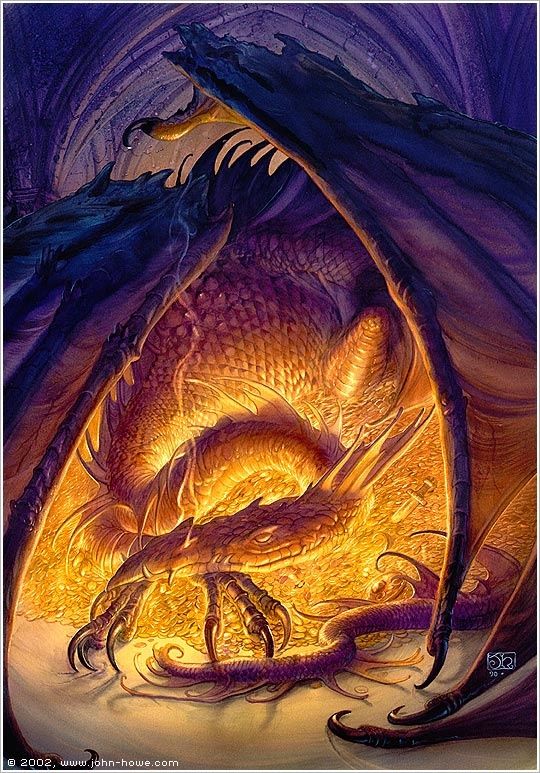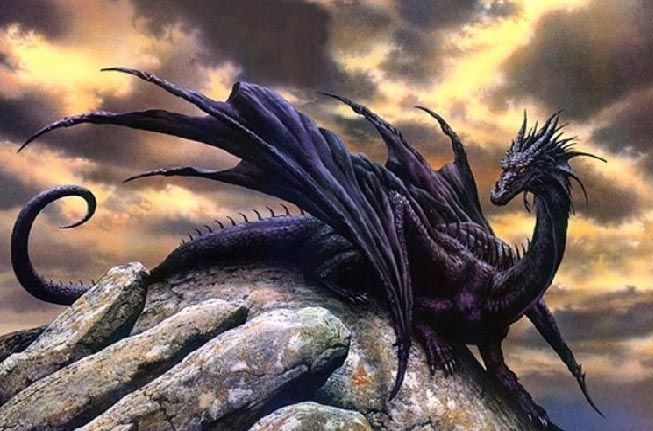SMAUG THE MAGNIFICENT

One of the last great dragons of Middle-earth, Smaug rose to prominence by laying waste to the town of Dale and capturing the Lonely Mountain (Erebor) with all of its treasure. He was already centuries old at the time, this having happened over 200 years before the events of The Hobbit. The book recounts the tale of a party of dwarves (consisting of a few of the original residents of the Lonely Mountain and their descendants) and the titular hobbit to recapture the mountain and kill the dragon. In the book, he is sometimes called Smaug the Golden or Smaug the Magnificent
Smaug was intimately familiar with every last item within his hoard, and instantly noticed the theft of a relatively inconsequential cup by Bilbo Baggins. According to Tolkien, his rage was the kind which "is only seen when rich folk that have more than they can enjoy lose something they have long had but never before used or wanted." This theft of a cup, Smaug's knowledge of every item in the hoard, and the dragon's ensuing rampage all echo the story of Beowulf, on which Tolkien was a noted expert and which he described as one of his "most valued sources" for The Hobbit.[1] Among the items in Smaug's possession were the Arkenstone, and a number of mithril mail shirts, one of which was given as a gift to Bilbo by Thorin Oakenshield, the company's leader. In The Lord of the Rings, set years later, the shirt saved Bilbo's relative Frodo from injury multiple times.
Smaug's belly was crusted in gems and gold, which rendered him almost invulnerable. However, when Bilbo met him in his lair, he discovered a bare patch on his left breast. When Bilbo told his Dwarf companions about Smaug's weakness, he was overheard by the thrush that roosted by the mountain's secret door. The thrush in turn told Bard the Bowman of Esgaroth. When Smaug attacked the town, Bard shot his Black Arrow into Smaug's left breast, the armour's weak spot, killing him.
After Smaug's death, Thorin and Company claimed the treasure as theirs by birthright. This created a conflict with Bard and the Elven king Thranduil of Mirkwood, who each wanted a portion of the gold as reimbursement for all the damage Smaug had caused their kingdoms over the years. Thorin refused to share the treasure as long as they stood in arms before his gate, and declared war on both of them. Conflict was avoided by the arrival of the Goblin and Warg army who wanted the treasure out of greed, and the Dwarves decided to ally with the Elves and Men to fight this greater evil in what was known as the Battle of Five Armies, during which Thorin was mortally wounded.
Smaug has the fiery breath generally associated with dragons, but is just as dangerous behind as before: his tail is described as having the power of a battering-ram wielded by giants, and when Bilbo foolishly gives him too many clues as to where his and the Dwarves' campsite is, Smaug uses this powerful tail to bring rubble down upon them to try to bury them all.
Smaug has exceptional eyesight, and also an acute sense of smell, which he is able to use asleep or awake. He is even able to put an exact figure on the number of people and ponies that arrive near his lair, and his appetite (he eats ten out of the fourteen ponies before he even has his conversation with Bilbo) is monstrous. He can also sleep with one eye open to keep watch over his treasure, which is how he manages to speak with Bilbo when he returns for more — although he has to admit to himself that he cannot decide what species Bilbo is by scent alone, the smell of a hobbit being unknown to him.
Smaug's weakness — which we are told by Tolkien is common among dragons — is that he enjoys riddles and cannot resist the urge to uncover them — although he has further strength in his abilities to give very accurate guesses and to keep what information he does uncover to himself. In common with Tolkien's other dragons, Smaug has power of hypnosis using his eyes; every time he looks towards the unseen Bilbo, he puts him "in mortal danger of falling under the dragon's spell", and makes him suddenly want to tell him everything. The eyes "rove" from side to side in search of him, however Bilbo is invisible with the help of the One Ring at the time and the impact of their power does not consume his mind completely. Smaug does, however, possess what is described as "quite an overwhelming personality", as well as a dry, if cruel, sense of humour, so that aside from coming close to making Bilbo betray his friends, he also causes him to temporarily believe that the dwarves are trying to swindle him out of his share of the treasure and that it would be impossible for them to remove it all even if they allowed him some.
A further weakness lies with Smaug's own pride: he believes himself to be invulnerable, and is unaware of the unarmoured patch of bare skin on his breast when he goes to Esgaroth to set the town alight and hunt its people. This arrogance eventually proves fatal to him in his battle with the town's defenders, though not before he has laid waste to the place. Though the dragon eventually lies dead and rotting at the bottom of the river, it is seen as ominous, and we are told there are none who dare to dive down and retrieve the treasure still attached to his body.
In the books, the name Smaug is presented as a translation of Trâgu in Tolkien's fictional language of "original Dalish", much like Sméagol/Trahald. According to Tolkien, the name Smaug is "the past tense of the primitive Germanic verb smeugan (Old Norse smjúga; past smaug) = "to squeeze through a hole"" (This is noted in the first chapter of The Hobbit when the Dwarves wonder how the dragon was able to squeeze through the passageway in the mountain). [5]
1. ^ Carpenter, Humphrey, ed. (1981), The Letters of J. R. R. Tolkien, Boston: Houghton Mifflin, Letter #25, ISBN 0-395-31555-7
2. ^ Hammond, Wayne; Scull, Christina (1995), J. R. R. Tolkien: Artist and Illustrator, Boston: Houghton Mifflin, Image #133, ISBN 0-395-74816-X
3. ^ Hammond, Wayne; Scull, Christina (1995), J. R. R. Tolkien: Artist and Illustrator, Boston: Houghton Mifflin, Image #137, ISBN 0-395-74816-X
4. ^ J. R. R. Tolkien, Beowulf: The Monsters and the Critics and Other Essays (ed. Christopher Tolkien, London: George Allen & Unwin, 1983).
5. ^ Letter No. 31

Dans l'œuvre de J. R. R. Tolkien, Smaug est un dragon qui vit sous le Mont Solitaire ou Erebor, dans la Terre du Milieu. Il a chassé les anciens occupants de la montagne, des Nains, pour récupérer leurs richesses et détruit la ville de Dale, occupée par des hommes, située au pied de la montagne; ainsi les habitants des régions proches d'Erebor n'eurent pas d'autre choix que de créer une nouvelle cité appelée Esgaroth.
Le roman de Tolkien Bilbo le hobbit raconte la grande aventure menée par treize Nains, un hobbit, Bilbon Sacquet, et le magicien Gandalf dans une quête pour rendre aux nains les trésors qui leur appartiennent. Smaug est tué d'une flèche, la flèche noire, issue de l'ancienne ville de Dale, tirée par le capitaine Bard dans le seul défaut de son armure de joyaux.
Smaug var, i J.R.R. Tolkiens fiktive univers Midgard, en grådig, rødlig gulldrake i Midgard, som ødela hele Dale og inntom Ensomfjellet med hele dets skatt, som han samlet i sentalhallen og sov på. Siden han hadde samlet hele skatten til dvergene som før bodde der, var han sannsynligvis kjent med hver eneste ting i den enorme skattehaugen, blant annet Arkensteinen og flere mithril-skjorter (en ble gitt bort til Bilbo Lommelun av Thorin Eikenskjold - og som reddet Frodo fra å bli gjennomboret av et spyd i Moria).
Smaugs størrelse og hans skjell gjorde ham nesten helt uskadelig, men når Bilbo Lommelun konfronterte ham i hans hule, oppdaget han at Smaug hadde en bar flekk på hans mage. Når Bilbo fortalte dette til hans dvergevenner, ble dette overhørt av en trost som satt over dem på fjellet. Dette fortalte trosten videre til Bard av Esgaroth, og når Smaug angrep Esgaroth, drepte Bard den mektige draken med hans svarte pil.
Etter Smaugs død, ble skatten begjært av Thorins og hans følge. Dette førte til en konflikt mellom Bard og Thranduil av Myrkskog - som også ville ha hver sin del av gullet som en erstatning for alt Smaug hadde ødelagt. Thorin avslo, og erklærte krig mot begge parter. Konflikten gikk over til å bli et slag, nemlig Femhærerslaget.
Ifølge Gandalv i Ringenes Herre, var det heldig at Smaug ble drept. Hadde han levd, ville han ha kommet under Saurons kontroll og ødelagt hele Myrkskog.
Smaugs størrelse og hans skjell gjorde ham nesten helt uskadelig, men når Bilbo Lommelun konfronterte ham i hans hule, oppdaget han at Smaug hadde en bar flekk på hans mage. Når Bilbo fortalte dette til hans dvergevenner, ble dette overhørt av en trost som satt over dem på fjellet. Dette fortalte trosten videre til Bard av Esgaroth, og når Smaug angrep Esgaroth, drepte Bard den mektige draken med hans svarte pil.
Etter Smaugs død, ble skatten begjært av Thorins og hans følge. Dette førte til en konflikt mellom Bard og Thranduil av Myrkskog - som også ville ha hver sin del av gullet som en erstatning for alt Smaug hadde ødelagt. Thorin avslo, og erklærte krig mot begge parter. Konflikten gikk over til å bli et slag, nemlig Femhærerslaget.
Ifølge Gandalv i Ringenes Herre, var det heldig at Smaug ble drept. Hadde han levd, ville han ha kommet under Saurons kontroll og ødelagt hele Myrkskog.
